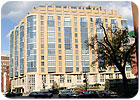
In kicking off the National Association of Home Builders (NAHB) 2006 Fall Construction Forecast Conference, David Seiders, chief economist for NAHB, said that a caption for the conference could be, "Will housing pull the U.S. economy into recession?" That's the "big question of the day," he noted.
The NAHB/Wells Fargo Housing Market Index topped out the middle of last year at around 70, Seiders said. By September it was down to 30. Single-family housing permit issuance "has been in essentially freefall," he said. The market has been contracting significantly.
The decline in housing affordability has been behind this housing correction, stated Seiders. Single-family inventory is rising rapidly. And new home inventory is probably understated due to cancellations by buyers. "The housing market is really in retreat," he said. "Housing is putting a heavy hit on the economy."
The nominal rate of house price appreciation is now shrinking rapidly, going negative in the absence of a recession. House price appreciation will solidify and get back into the positive area in 2008, Seiders said.
Single-family housing starts peaked out in the first quarter. They will decline through the second quarter of next year, he said, then come back up.
Residential remodeling will see a slowdown in growth, but is still expected to grow.

"Oil prices are going in the right direction right now," said Wyss, but they could go back up again. He believes oil prices will stay down at present, but the situation in the Middle East could quickly change that. In the long run, he believes oil prices will go up.
However, Wyss said, we are less dependent on oil now than we used to be. Americans used to spend 8 percent of their income on energy. Now they spend 5-1/2 percent on energy.
Household debt has hit a record as saving goes negative. Debt service is now about 18-1/2 percent of income but it seems bearable. "But we expect it to move to over 20 percent," said Wyss, and consumer spending is expected to slow down.
Home prices are high relative to household income. The current home price to disposable income ratio of 3.5 is a new record. Home prices in some cities "have become extremely overvalued," he said. San Diego, Los Angeles, San Francisco, and San Jose are at the top of the most expensive list. This is a problem in those areas.
People are going to find renovation cheaper than trading up to a new home, Wyss stated, so that's why he thinks remodeling will rise while the housing market declines.
Maury Harris, chief economist for the Americas for UBS Warburg Research, remarked that he's more pessimistic than the other panelists. He said that real GDP growth will slow to a 2 percent pace in the second half of this year, and will be at 2.4 percent in 2007.
The most important economic fundamental had been housing. The booming real estate market had added 1 percent per year to growth, said Harris. We now have housing-related uncertainty following the unprecedented boom.
"We've never seen anything like this before," he said.
Harris sees oil prices at about $68 per barrel next year, but he doesn't think it will have a big impact on the economy.
Inflation is expected to slow next year, he said. Inflation crosscurrents include productivity slowing to trend, a projected lower dollar, only moderate wage acceleration, and slower output and demand growth.
Borrowing on the home became bigger and bigger as house prices rose, but median existing home sales prices have dropped sharply, Harris said. So "there will be a drop-off in home equity extraction," which will slow down consumer spending.

REGIONAL OUTLOOK
Providing a regional housing outlook, Mark Zandi, chief economist of Moody's Economy.com, stated that if the housing market stabilizes, the economy will stabilize.Like Harris, Zandi said that housing has been driving the economy's performance. In 2005, housing was responsible for adding 1 percent to GDP growth. This year, he said, it will subtract 1/4 percent from GDP growth. In 2007, it is expected to subtract 3/4 percent.
The construction industry confidence index was very high in 2005 and early 2006, but it has been falling since then, Zandi said. Home sales "will hit bottom in three to six months," he noted. Housing starts "will hit bottom in six to nine months." Housing prices will bottom out in nine to 12 months. Many metro areas across the country have been seeing a weakening in single-family construction.
The housing decline is due to three factors, he said. One is housing affordability. Lenders were creative with their mortgages, but the Federal Reserve's higher interest rates have slowed down the market. Areas where affordability is now a problem include California, Florida, Arizona, and Washington, D.C., Zandi pointed out.
A second factor in the housing decline is that investors are exiting the market. "Half the nation's housing market is overvalued," he said, and prices will decline over the next year. Investor activity has been high in California, Arizona, Nevada, Florida, and areas along the East Coast. "Prices will come down in these markets one way or another."
The third factor for the decline in housing is overbuilding. "There are too many homes out there," Zandi asserted. Assuming the market was balanced in 2003, we need to work off about 400,000 homes. Because of this, we will have below trend housing construction for the next two years.
Zandi believes that home equity borrowing did have a positive effect on consumer spending. Home equity borrowing is now dropping and we'll now see a slowdown in consumer spending. He said this will particularly occur along the coasts.
Bernard Markstein, director of forecasting for NAHB, commented that in the fourth quarter of 2005 there was growth in housing starts across the country. Now in the fourth quarter of 2006, almost all states are down significantly. "By the fourth quarter of 2007, we will be seeing an improvement."
Starts per capita in 2005 were very high in the Southeast and Southwest, he said. In 2006, we returned to a more normal level. In 2007, it is expected to actually be below normal then recover in 2008 and 2009.
The forces driving regional housing demand, said Markstein, include the following:

Sidebar: Multifamily Outlook
In addition to the single-family housing market, the National Association of Home Builders (NAHB) 2006 Fall Construction Forecast Conference also discussed the multifamily construction outlook. Ron Witten, president of Witten Advisors, a market advisory firm serving apartment developers, investors, and lenders, provided his insights into this segment.Witten said that apartment market performance saw a substantial dip in 2001 through 2003. It has now been heading up since 2004. Apartment occupancy and rent trends are now strong, driven by very healthy demand.
"Job growth is one of the most important drivers of rental growth," said Witten. Job growth is slowing now in 2006 into 2007, but it is expected to come back up later in 2007. Commercial construction is taking up part of the job slack.
"A wider rent-buy gap also drives rental demand," he said. The premium to buy a home is now 80 percent nationally, widening dramatically in the last few quarters. "Home buying now is not an affordable option for an awful lot of people."
Looking at the condo market, existing condo sales are off moderately. Inventories are rising and prices are softening. Condo conversion activity (apartment units bought with intent to convert to condos) is drying up, Witten said.
The post-2001 decline in interest rates was great for apartment owners, Witten related. Lower rates supported new rental development. Yields on rental development should now end their slide.
Actual multifamily starts are steady though permits are rising. So we have mixed signals on the construction side, he said.
Demand is expected to be greater than supply through 2007. Looking at the top demand growth markets, as of second quarter 2006 figures, the top five cities are Houston, Atlanta, Dallas, Chicago, and Boston. Several metro areas have seen a spike in multi-family permits, including Austin, Texas; Las Vegas; Miami; and San Antonio.
The top markets for multifamily rental starts in 2006, said Witten, are: Houston, Dallas, Atlanta, Miami, and Austin. For 2007, he expects the top four to remain the same, with Los Angeles moving into the No. 5 slot.
Publication date: 11/27/2006




